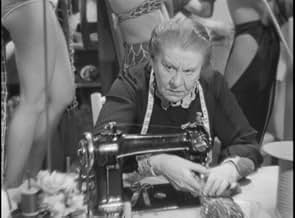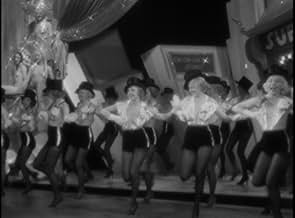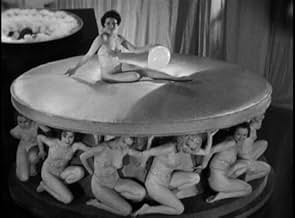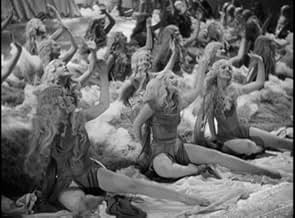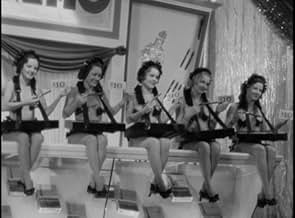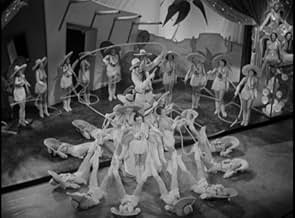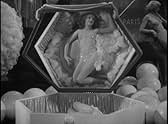AVALIAÇÃO DA IMDb
6,5/10
1 mil
SUA AVALIAÇÃO
Adicionar um enredo no seu idiomaA homicide detective with an eye for the ladies, investigating a murder in Earl Carroll's Vanities, allows the music revue to continue during the investigation.A homicide detective with an eye for the ladies, investigating a murder in Earl Carroll's Vanities, allows the music revue to continue during the investigation.A homicide detective with an eye for the ladies, investigating a murder in Earl Carroll's Vanities, allows the music revue to continue during the investigation.
- Direção
- Roteiristas
- Artistas
- Prêmios
- 1 vitória no total
Charles Middleton
- Homer Boothby
- (as Charles B. Middleton)
Ernestine Anderson
- Earl Carroll Girl
- (não creditado)
Lona Andre
- Lona - Earl Carroll Girl
- (não creditado)
William Arnold
- Treasurer
- (não creditado)
Lucille Ball
- Earl Carroll Girl
- (não creditado)
Lucille Battle
- Black Dancer in Ebony Rhapsody number
- (não creditado)
Avaliações em destaque
A Murder investigation goes on back stage while The Vanities, on its opening night, plays on to an unknowing audience. Odd combination of musical and murder mystery is worth a look for its cast, its terrific production numbers, and the sheer novelty of the film.
Gertrude Michael has the showy role of a bitchy actress intent on stopping the marriage between the show's stars, Kitty Carlisle and Carl Brisson, as well as starring in the infamous "Sweet Marijuana" number (which was also on a 70s Bette Midler album). So while the chorus girls shuffle around backstage, bumbling detective Victor McLaglen ogles the girls while he tries to solve the backstage murder of an unknown woman whose body is found on a catwalk above the stage.
We quickly learn that the maid (Dorothy Stickney) loves Brisson from afar, that the wardrobe lady (Jessie Ralph) is Brisson's mother, and that the stage manager (Jack Oakie) butts into everything. Lots of plots twists among the musical numbers. The show's best-known song is "Cocktails for Two" sung by Brisson and Carlisle. They also sing "Live and Love Tonight" on a tropical isle surrounded by showgirls waving feather fans to simulate the ocean. Carlisle also sings the haunting "Where Do They Come From?" Gertrude Michael sings the infamous "Sweet Marijuana." And there's a weird rhapsody that erupts into a Harlem specialty number featuring Duke Ellington!
Some terrific acting here, especially Gertrude Michael and Dorothy Stickney. Kitty Carlisle is quite good as well. Brisson, Oakie, and McLaglen are all solid.
Charles Middleton plays Homer, Toby Wing plays Nancy, Donald Meek plays the doctor, Gail Patrick plays the unknown woman, and see if you can spot Ann Sheridan, Alan Ladd and Lucille Ball among the chorus members.
Gertrude Michael has the showy role of a bitchy actress intent on stopping the marriage between the show's stars, Kitty Carlisle and Carl Brisson, as well as starring in the infamous "Sweet Marijuana" number (which was also on a 70s Bette Midler album). So while the chorus girls shuffle around backstage, bumbling detective Victor McLaglen ogles the girls while he tries to solve the backstage murder of an unknown woman whose body is found on a catwalk above the stage.
We quickly learn that the maid (Dorothy Stickney) loves Brisson from afar, that the wardrobe lady (Jessie Ralph) is Brisson's mother, and that the stage manager (Jack Oakie) butts into everything. Lots of plots twists among the musical numbers. The show's best-known song is "Cocktails for Two" sung by Brisson and Carlisle. They also sing "Live and Love Tonight" on a tropical isle surrounded by showgirls waving feather fans to simulate the ocean. Carlisle also sings the haunting "Where Do They Come From?" Gertrude Michael sings the infamous "Sweet Marijuana." And there's a weird rhapsody that erupts into a Harlem specialty number featuring Duke Ellington!
Some terrific acting here, especially Gertrude Michael and Dorothy Stickney. Kitty Carlisle is quite good as well. Brisson, Oakie, and McLaglen are all solid.
Charles Middleton plays Homer, Toby Wing plays Nancy, Donald Meek plays the doctor, Gail Patrick plays the unknown woman, and see if you can spot Ann Sheridan, Alan Ladd and Lucille Ball among the chorus members.
I just viewed MURDER AT THE VANITIES in the newly-released Universal Pre-Code set, and I was amazed at how much I enjoyed the vehicle end to end. Most of the other commentators have covered the story, a murder mystery within a musical, but I wanted to add a few additional notes. Brisson and Carlisle are relatively bland, compared to even most of the minor players, and neither one really seems to have the proper voice for what they're singing (Carlisle being a trained opera singer, Brisson a bit wobbly on some of his high and low notes). The great Victor McLaglen and Jack Oakie play well off each other, with an excellent sense of timing that keeps the ball rolling between musical numbers. Yes, Lucille Ball and Ann Sheridan are Vanities girls, but let's not forget the splendid jazz singer Ernestine Anderson in the "Ebony Rhapsody" number. Gail Patrick makes one of her early appearances, sounding a bit like Eve Arden; Patrick would go on to become the executive producer of the Perry Mason TV series. Then there's Jessie Ralph as the wardrobe mistress--you'll spot her also in David COPPERFIELD (as Aunt Peggoty) and THE BANK DICK. The music is very good--Brisson introducing the standard "Cocktails for Two" in two different scenes; "Sweet Marihuana" with barely clad peyote button girls in the background (blood dripping on one chorine's white skin was wonderfully chilling); the "Ebony Rhapsody," with Duke Ellington's Orchestra and a bevy of beautiful dancers, both black and white, mixing it up. And I believe this is one of the only early musicals to feature such a mix--and the costumes leave nothing to the imagination.
A fast-paced murder mystery set backstage at a performance of Earl Carroll's Vanities.
It's clear the filmmakers' primary motivation was to showcase the Vanities and realized they needed to wrap a movie around it. Far more screen time is given to the lavish musical numbers featuring countless scantily clad women than to the mechanics of the nominal plot, but that's not a criticism. It's rather fascinating to see this unique brand of stage entertainment captured in all its antiquated glory, and honestly the women are more interesting to watch than the story anyway. And though this is mostly a disposable B movie, it really does come alive in a special way during some of the musical moments, and some of the magic of seeing this kind of show performed live is captured on screen.
The cast includes an appealing Kitty Carlisle and a humorous Victor McLaglen, right before he was to win an Oscar for John Ford's "The Informer." Duke Ellington also makes a cameo.
Pretty fun stuff.
Grade: B+
It's clear the filmmakers' primary motivation was to showcase the Vanities and realized they needed to wrap a movie around it. Far more screen time is given to the lavish musical numbers featuring countless scantily clad women than to the mechanics of the nominal plot, but that's not a criticism. It's rather fascinating to see this unique brand of stage entertainment captured in all its antiquated glory, and honestly the women are more interesting to watch than the story anyway. And though this is mostly a disposable B movie, it really does come alive in a special way during some of the musical moments, and some of the magic of seeing this kind of show performed live is captured on screen.
The cast includes an appealing Kitty Carlisle and a humorous Victor McLaglen, right before he was to win an Oscar for John Ford's "The Informer." Duke Ellington also makes a cameo.
Pretty fun stuff.
Grade: B+
Earl Carroll's MURDER AT THE VANITIES (Paramount, 1934), directed by Mitchell Leisen, from the stage work by Earl Carroll and Rufus King, marked the studio's contribution to the stage musical of the precode era. Almost in the league as Warner Brothers' WONDER BAR (1934), with plot set in a single night revolving around an handful of sinful characters, VANITIES contains its own assortment of odd characters, great interplay between Jack Oakie and Victor McLaglen, risqué dialog and semi-nude chorines listed in the opening credits as "The Most Beautiful Girls in the World," makes this particular production something to consider.
Producer Earl Carroll is ill and unable to attend the opening night of his Vanities, which leaves Jack Ellery (Jack Oakie), former reporter turned stage director, in charge. Eric Lander (Carl Brisson) and Anne Ward (Kitty Carlisle), the show's leading couple, plan on getting married after the performance, much to the dismay of temperamental blues singer, Rita Ross (Gertrude Michael), who wants Eric for herself and will stop at nothing to get him. Before the curtain goes up, Anne finds her life being threatened by falling props and sandbags that nearly miss her, causing Ellery to notify his friendly rival, Police Lieutenant Bill Murdock (Victor McLaglen) to investigate. Sadie Evans (Gail Patrick), a female investigator hired by Eric, arrives to return valuable information stolen from him by Rita. Because Miss Evans has learned more than she should, her life is threatened by Helene Smith (Jessie Ralph), a wardrobe woman with a mysterious past of her own. During a performance, blood is felt dripping upon a chorus girl, causing her to scream and Murdock to trace the dripping blood to the body of Sadie Evans, stabbed by a large pin. When Rita threatens to expose what she knows about Eric in Vienna, she, too is murdered by a mysterious bullet. The show goes on as Ellery and Murdock work together in hope of rounding up the usual suspects.
Other members of the cast include Charles Middleton as Shakespearean actor Homer Boothby; Donald Meek as Doctor J.T. Saunders; and Barbara Fritchie as Viven. Notable performances go out to the comic-strip appearance of Dorothy Stickney as Norma Watson, Rita's abused maid; and Toby Wing as Nancy, the giggly blonde wanting desperately some time alone with Jack Ellery, who constantly casts her aside until later. Kitty Carlisle, best known for her role opposite the Marx Brothers in A NIGHT AT THE OPERA (MGM, 1935), and as TV's panelist on the 1960-70s quiz show, TO TELL THE TRUTH, performs well in her motion picture debut, especially opposite Carl Brisson who, at times, resembles Carlisle's NIGHT AT THE OPERA love interest, Allan Jones, but minus the Danish accent.
A well-crafted murder mystery with an abundance of fine tunes by Arthur Johnson, Sam Coslow and Johnny Burke, include: "Cocktails for Two" (sung by Carl Brisson); "Where Do They Come From and Where Do They Go?" (sung by Kitty Carlisle); "Lovely One" (sung by male chorus); "Where Do They Come From and Where Do They Go?" (concluded by Carlisle); "Live and Love Tonight" (sung by Brisson); "Sweet Marijuana" (sung by Gertrude Michael); "Cradle Me With a Hatcha Lullaby" (instrumentally performed by male dancers); "The Rape of the Rhapsody" (sung by Brisson, orchestrated by Duke Ellington and his Band; reprized by Kitty Carlisle); "Doing the Ebony Rhapsody" (sung by Gertrude Michael); "Cocktails for Two" (sung by Brisson, chorus); and Finale: "Live and Love Tonight," "Sweet Marijuana" and "Cocktails for Two."
While "Cocktails for Two" became a song hit that that was later spoofed in the 1940s by band-leader Spike Jones, "Live and Love Tonight" is actually one of the better and nicer tunes helped by its production number treatment set on an island with Brisson as the sole male surrounded by under-dressed island girls (Carlisle included) and others using ostrich feathers as water waves. Gertrude Michael's rendition to "Sweet Marijuana" surrounded by dancing shadows, appears to be the sort of tune 35 years ahead of its time, fitting more into the 1960s hippie generation than 1934. Franz Liszt's "Second Hungarian Rhapsody," the longest of the production numbers, is an interesting attempt turning slow tempo classical composition to upbeat jazzy orchestration with Duke Ellington at the piano. Larry Ceballos and LeRoy Prinz are credited for their impressive (or suggestive) choreography.
Rarely televised possibly due to its subject matter that make precode movies all the more worth seeing today, MURDER AT THE VANITIES, having been one of an assortment of rare classic films aired Sunday nights (1974-75) on Hartford, Connecticut's WFSB, Channel 3, did become available on home video in the 1980s (retail price: $59.95) and finally DVD in 2009. Its availability should add to the rediscovery of buried treasures such as this. (***)
Producer Earl Carroll is ill and unable to attend the opening night of his Vanities, which leaves Jack Ellery (Jack Oakie), former reporter turned stage director, in charge. Eric Lander (Carl Brisson) and Anne Ward (Kitty Carlisle), the show's leading couple, plan on getting married after the performance, much to the dismay of temperamental blues singer, Rita Ross (Gertrude Michael), who wants Eric for herself and will stop at nothing to get him. Before the curtain goes up, Anne finds her life being threatened by falling props and sandbags that nearly miss her, causing Ellery to notify his friendly rival, Police Lieutenant Bill Murdock (Victor McLaglen) to investigate. Sadie Evans (Gail Patrick), a female investigator hired by Eric, arrives to return valuable information stolen from him by Rita. Because Miss Evans has learned more than she should, her life is threatened by Helene Smith (Jessie Ralph), a wardrobe woman with a mysterious past of her own. During a performance, blood is felt dripping upon a chorus girl, causing her to scream and Murdock to trace the dripping blood to the body of Sadie Evans, stabbed by a large pin. When Rita threatens to expose what she knows about Eric in Vienna, she, too is murdered by a mysterious bullet. The show goes on as Ellery and Murdock work together in hope of rounding up the usual suspects.
Other members of the cast include Charles Middleton as Shakespearean actor Homer Boothby; Donald Meek as Doctor J.T. Saunders; and Barbara Fritchie as Viven. Notable performances go out to the comic-strip appearance of Dorothy Stickney as Norma Watson, Rita's abused maid; and Toby Wing as Nancy, the giggly blonde wanting desperately some time alone with Jack Ellery, who constantly casts her aside until later. Kitty Carlisle, best known for her role opposite the Marx Brothers in A NIGHT AT THE OPERA (MGM, 1935), and as TV's panelist on the 1960-70s quiz show, TO TELL THE TRUTH, performs well in her motion picture debut, especially opposite Carl Brisson who, at times, resembles Carlisle's NIGHT AT THE OPERA love interest, Allan Jones, but minus the Danish accent.
A well-crafted murder mystery with an abundance of fine tunes by Arthur Johnson, Sam Coslow and Johnny Burke, include: "Cocktails for Two" (sung by Carl Brisson); "Where Do They Come From and Where Do They Go?" (sung by Kitty Carlisle); "Lovely One" (sung by male chorus); "Where Do They Come From and Where Do They Go?" (concluded by Carlisle); "Live and Love Tonight" (sung by Brisson); "Sweet Marijuana" (sung by Gertrude Michael); "Cradle Me With a Hatcha Lullaby" (instrumentally performed by male dancers); "The Rape of the Rhapsody" (sung by Brisson, orchestrated by Duke Ellington and his Band; reprized by Kitty Carlisle); "Doing the Ebony Rhapsody" (sung by Gertrude Michael); "Cocktails for Two" (sung by Brisson, chorus); and Finale: "Live and Love Tonight," "Sweet Marijuana" and "Cocktails for Two."
While "Cocktails for Two" became a song hit that that was later spoofed in the 1940s by band-leader Spike Jones, "Live and Love Tonight" is actually one of the better and nicer tunes helped by its production number treatment set on an island with Brisson as the sole male surrounded by under-dressed island girls (Carlisle included) and others using ostrich feathers as water waves. Gertrude Michael's rendition to "Sweet Marijuana" surrounded by dancing shadows, appears to be the sort of tune 35 years ahead of its time, fitting more into the 1960s hippie generation than 1934. Franz Liszt's "Second Hungarian Rhapsody," the longest of the production numbers, is an interesting attempt turning slow tempo classical composition to upbeat jazzy orchestration with Duke Ellington at the piano. Larry Ceballos and LeRoy Prinz are credited for their impressive (or suggestive) choreography.
Rarely televised possibly due to its subject matter that make precode movies all the more worth seeing today, MURDER AT THE VANITIES, having been one of an assortment of rare classic films aired Sunday nights (1974-75) on Hartford, Connecticut's WFSB, Channel 3, did become available on home video in the 1980s (retail price: $59.95) and finally DVD in 2009. Its availability should add to the rediscovery of buried treasures such as this. (***)
Thus sumptuous Paramount art deco musical is almost a definitive pre code extravaganza and is on per with WONDERBAR and FASHIONS OF 1934 and TOP HAT as the glittering perfection of code- cusp risqué showgirl and nightclub sophisticated sexiness. Made at Paramount in late 1933 and clearly designed to outshine the WB Busby Berkeley extravaganzas, this one does it with nude showgirls, drug references, weapons, a slinky killer, murder in the ceiling and dripping blood, and big stage show numbers all crammed over the orchestra pit on the opening night of a big Broadway show. I was reminded of almost every Busby Berkeley film but clearly on a lower budget with the difference being made up by having spectacular costumes. In color this film would be an enduring musical of its time. In gorgeous B&W it still rates but one can see how colorful the costumes are even in monochrome. One startling song SWEET MARIJUANA manages the unparalleled feat of including nudity drugs murder and blood all on screen during the tune. There is a hilarious and nutty island mermaid number and a fantastic and simple art deco staging of COCKTAILS FOR TWO. This film clearly influenced THE GREAT ZIEGFELD made at MGM in 1936.
Você sabia?
- CuriosidadesMany of the Earl Carroll Girls featured in the film were authentic cast members from Carroll's stage show, which ran from September 12th to November, 1933, at the New Amsterdam Theatre, and at the Majestic Theatre from November 6th, 1933 to March 10th, 1934. These cast members were brought out to Hollywood from New York especially for this film, and many stayed to pursue film careers.
- Erros de gravaçãoWhen the body of the woman on the catwalk is turned on her back, you can see the actress' chest rise and fall as she takes a breath.
- Citações
[last lines]
Jack Ellery: Nancy, what shall I do?
Nancy: Oh, Mr. Ellery!
Jack Ellery: C'mon, let's do it.
- ConexõesEdited into Ondas Sonoras de 1937 (1936)
- Trilhas sonorasEbony Rhapsody
(uncredited)
by Arthur Johnston and Sam Coslow
Sung by Carl Brisson, Kitty Carlisle and Gertrude Michael
Principais escolhas
Faça login para avaliar e ver a lista de recomendações personalizadas
- How long is Murder at the Vanities?Fornecido pela Alexa
Detalhes
- Data de lançamento
- País de origem
- Idioma
- Também conhecido como
- Murder at the Vanities
- Locações de filme
- Empresa de produção
- Consulte mais créditos da empresa na IMDbPro
- Tempo de duração1 hora 29 minutos
- Cor
- Proporção
- 1.37 : 1
Contribua para esta página
Sugerir uma alteração ou adicionar conteúdo ausente

Principal brecha
By what name was Segue o Espetáculo (1934) officially released in India in English?
Responda

